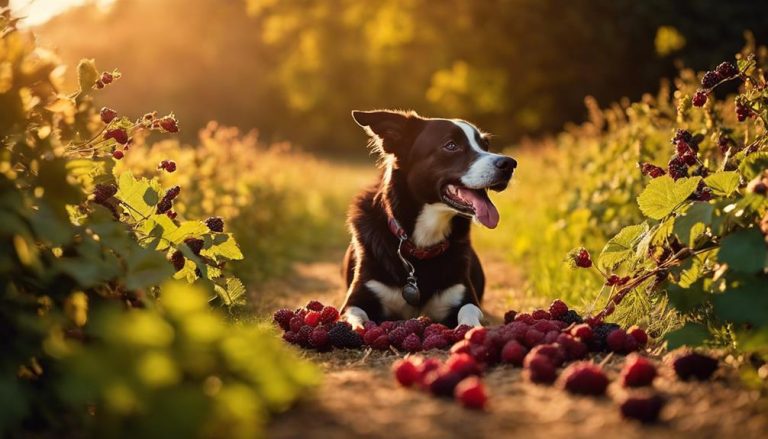Dogs and Mulberries: Safe Consumption?
Mulberries are generally safe for dogs to eat in small amounts. These fruits are packed with nutrients like vitamin C, iron, antioxidants, and fiber that can support a dog’s immune system, lower inflammation, and improve overall health.
However, only ripe mulberries should be fed to dogs, as the unripe ones contain harmful substances. Overfeeding can lead to sleepiness and stomach problems, so it’s best to keep an eye on your dog after they eat mulberries.
If you notice any issues, talking to a vet is a good idea. This balance of benefits and risks offers guidance on how to include mulberries in a dog’s diet safely.
Key Takeaways
- Dogs can safely enjoy ripe mulberries in small amounts.
- Unripe mulberries may cause digestive upset and odd behaviors.
- Ripe ones offer nutrients like vitamins and fiber.
Mulberries and Dog Safety
Mulberries are generally safe for dogs to eat. This means you can let your pet enjoy these berries without worrying about them being poisonous. However, it’s key to give them in moderation. Eating too many mulberries can lead to stomach upset or make your dog unusually sleepy. These effects usually go away on their own within a day.
If your dog eats mulberries, watch for signs of discomfort. It’s best to talk to a vet if you notice anything unusual. This way, your dog can enjoy the health benefits of mulberries without the downsides of eating too many.
Health Benefits for Dogs

Adding mulberries to your dog’s diet can be a great way to boost their immune system and improve their overall health. These berries are packed with vitamin C, iron, and antioxidants, which are all vital for keeping your dog healthy.
Vitamin C and iron work together to strengthen the immune system. This means your dog is better protected against illnesses. Antioxidants play a big role in fighting off diseases and keeping your dog healthy. They can also reduce inflammation, which helps your dog stay active and lively.
Mulberries are also a good source of fiber, which is key for healthy digestion. A diet rich in fiber ensures your dog’s digestive system runs smoothly, allowing them to absorb more nutrients from their food. The antioxidants in mulberries, such as resveratrol, not only protect against diseases but may also contribute to a longer, healthier life for your dog.
Incorporating mulberries into your dog’s meals can be a simple way to provide these health benefits. However, it’s important to add them in moderation and as part of a balanced diet. This approach underlines the need for a diet that supports your dog’s health in various ways, with mulberries acting as a tasty and nutritious part of that plan.
Feeding Dogs Mulberries Properly
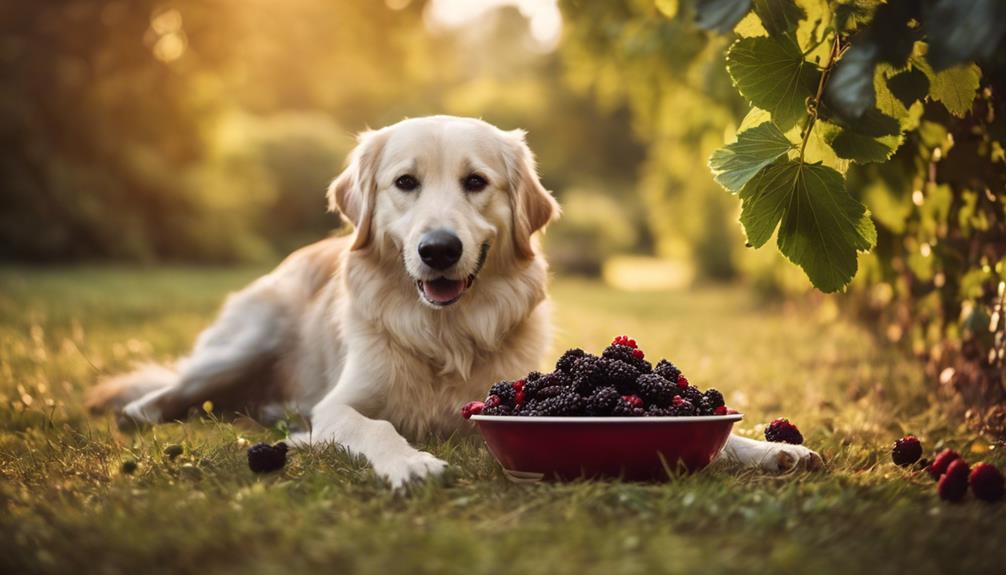
Ensuring the well-being and safety of dogs involves considering the nutritional value, right serving size, and possible allergic reactions when giving them mulberries.
Knowing how mulberries benefit a dog’s diet helps owners feed this fruit safely. It’s also vital to watch for allergy signs and serve the correct amount to avoid health issues, promoting a nutritious feeding routine.
Mulberry Nutritional Benefits
Adding mulberries to your dog’s diet can be a great move, thanks to their impressive nutritional benefits. Mulberries are not just any berry; they are a powerhouse of nutrients that can boost your pet’s health in several ways. For starters, they are rich in resveratrol, a substance known for fighting inflammation and potentially protecting against cancer. This makes them an exceptional choice for keeping your dog healthy.
These berries are also full of dietary fiber, which is great for your dog’s digestive system, ensuring that everything runs smoothly. They support the efficient digestion and absorption of different nutrients, which is vital for your dog’s overall health. Plus, mulberries are packed with iron and vitamins, which are essential for maintaining good blood circulation and vitality. This means your dog could have more energy and a stronger immune system.
Another fantastic benefit is the presence of anthocyanins in mulberries, which are antioxidants that may help in preventing tumor growth. This is crucial for dogs, especially as they age and become more susceptible to health issues. On top of all these benefits, mulberries are made up of about 80% water. This makes them an excellent snack for keeping your dog hydrated, especially on hot days or after exercise. And since they are lower in sugar compared to many other fruits, they can be a part of a balanced diet without causing spikes in blood sugar levels.
Proper Mulberry Portions
Understanding the benefits of mulberries for dogs is key. These berries, rich in resveratrol and antioxidants, can be a healthy snack for your pet when given in the right amounts. Here’s how to ensure your dog enjoys mulberries without any issues:
- Limit the Amount: It’s best to give your dog only a small number of mulberries. This prevents any stomach problems from arising.
- Choose Ripe Berries: Unripe mulberries could upset your dog’s stomach or even cause hallucinations, so it’s crucial to stick to ripe ones.
- Watch Your Dog: After giving your dog mulberries for the first time, keep an eye on them. This helps make sure they don’t have a bad reaction to the fruit.
Potential Allergic Reactions
While allergic reactions to mulberries in dogs don’t happen often, it’s key to watch out for signs like itching, swelling, or trouble breathing. These could mean your dog isn’t handling the fruit well. Skin rashes, hives, or an upset stomach after eating mulberries are also signs to look out for.
If your dog shows any of these symptoms, getting in touch with a vet right away is critical for the right advice and action. The severity of these reactions can range, so it’s vital to get veterinary help quickly if things seem serious.
When adding mulberries to your dog’s meals, doing it slowly is smart, especially if they’ve had food allergies before. This way, you can keep an eye out for any negative responses.
Risks of Unripe Mulberries
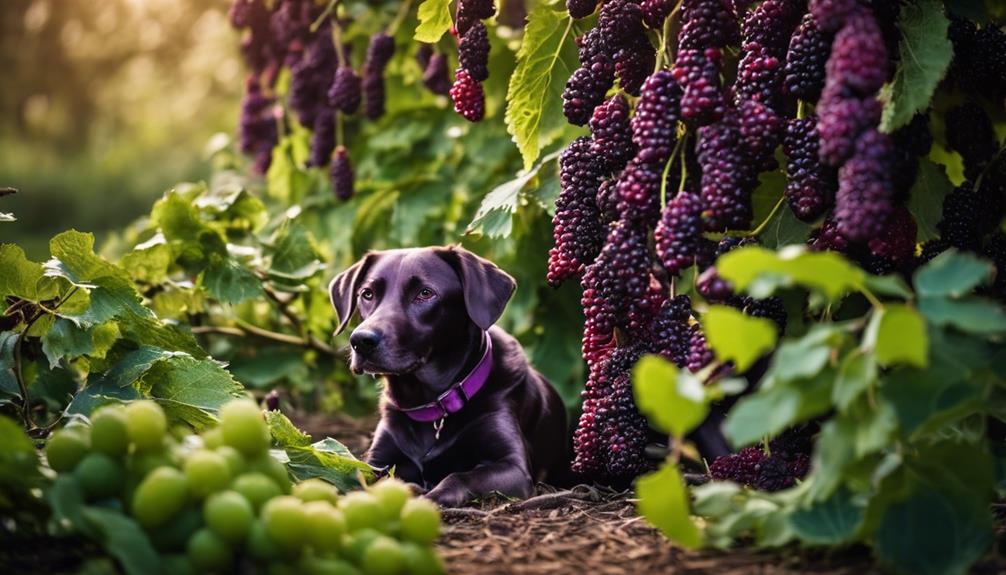
Eating unripe mulberries can be dangerous for dogs, as these fruits contain higher levels of harmful substances like alkaloids when not fully mature. These toxins can cause issues such as upset stomachs and even hallucinations in dogs. It’s crucial for pet owners to ensure their dogs only snack on ripe mulberries to avoid these health concerns.
Key points to remember include:
- Dogs can experience digestive discomfort from eating unripe mulberries.
- Unripe mulberries have more toxins compared to ripe ones.
- To prevent health risks, make sure your dog only eats ripe mulberries.
Mulberries in Dog Treats

Adding mulberries to dog treats can be a great way to boost your pet’s health because of the fruit’s nutrients. To prevent any negative reactions, it’s key to keep the serving size small.
Making your own dog treats with mulberries allows you to control how much of the fruit your pet eats. Use only ripe mulberries and keep sugar to a minimum.
Watch how your dog reacts to these treats. Adjust the amount and how often you give them these snacks to avoid any stomach problems.
Mulberry Treats: Nutritional Value
Mulberries, packed with vital nutrients like vitamin C, vitamin K, and iron, are great for dog treats. Adding this fruit to your dog’s diet can significantly boost their intake of essential vitamins and minerals. Including mulberry leaves in dog treats also increases their nutritional benefit, offering a natural way to enhance your pet’s diet.
- The antioxidants in mulberries help support a healthy immune system and protect dogs from illnesses.
- Their fiber content is good for digestion and maintaining a healthy gut.
- Resveratrol in mulberries has anti-inflammatory effects, which is beneficial for a dog’s health.
These features make mulberries an excellent choice for dog treats, combining health benefits with a tasty treat.
Safe Serving Sizes
Determining the correct portion of mulberries for your dog is crucial for their health and happiness. A small number of these berries can be a safe treat, packed with nutrients beneficial for your pet. It’s essential to introduce mulberries slowly, starting with a tiny amount. This approach helps in observing how your dog reacts to this new treat.
Moderation is key to avoid any digestive problems. Too many mulberries can upset your dog’s stomach, causing discomfort or diarrhea. After giving your dog mulberries for the first time, watch them closely. This step ensures they’re not having a negative reaction to the fruit.
Following these simple guidelines will allow your dog to safely enjoy the natural sweetness of mulberries. It’s all about finding a balance that allows them to reap the nutritional benefits without any adverse effects.
Homemade Mulberry Dog Recipes
Making homemade mulberry treats for dogs is a great way to mix the health benefits of ripe mulberries with dog-friendly ingredients like oats and yogurt. This combination creates a nutritious snack that’s perfect for your pet. Using fresh mulberries ensures your dog gets the best of the fruit’s vitamins and antioxidants.
- Use ripe mulberries for their health benefits and sweetness.
- Mix with safe ingredients such as oats or yogurt for a well-rounded snack.
- Cook in small amounts to keep treats fresh and help with portion control.
These treats are a creative and beneficial addition to your dog’s diet.
White Vs. Red Mulberries
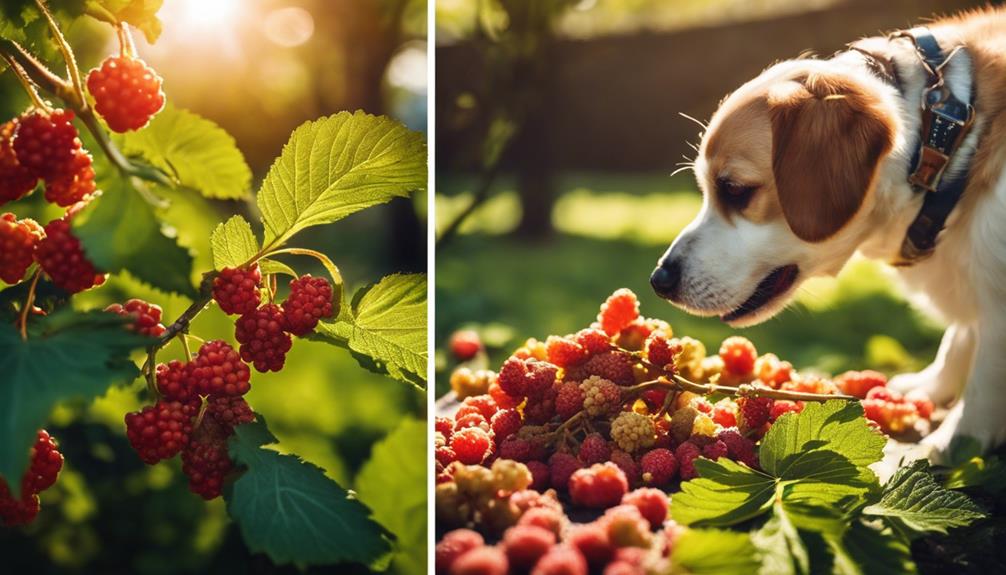
When looking at white and red mulberries, it’s key to note that each has its own set of benefits and considerations for dogs. White mulberries come from the Morus Alba tree and besides being a favorite for silkworms, they’re a great little treat for dogs in moderation. They pack a nutritional punch without posing major health risks.
Conversely, red mulberries are loaded with antioxidants that are great for blood health but they’re also high in insoluble fiber. This means they should be given to dogs sparingly to avoid upset stomachs. Keeping an eye on how much your dog eats is crucial to avoid any digestive problems and keep them happy and healthy.
Dried Mulberries and Dogs
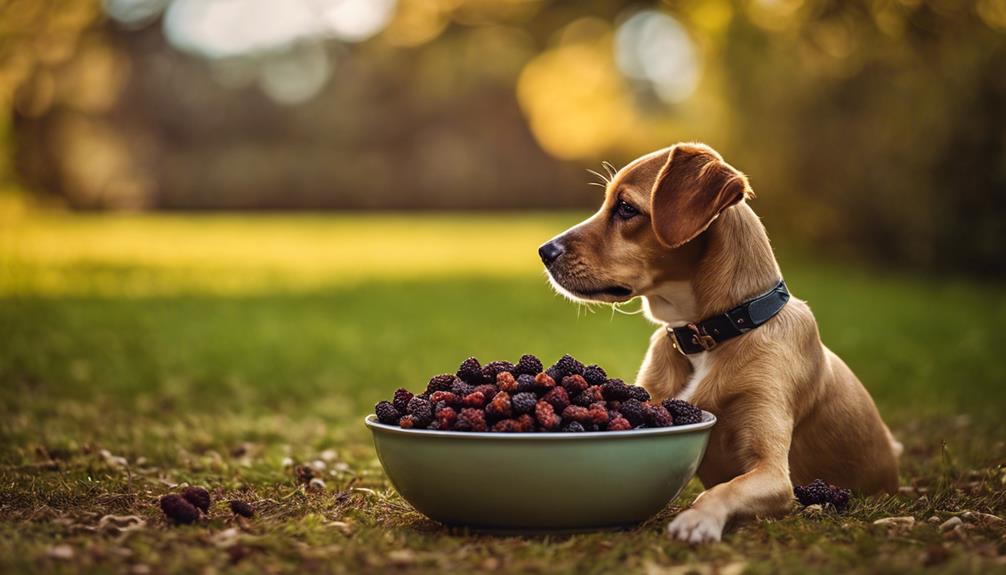
When it comes to feeding dogs, it’s crucial to consider the sugar content in their snacks. Dried mulberries have a lot more sugar compared to the fresh ones because the drying process removes water, leaving behind a denser sugar content. This can be a problem for dogs, potentially leading to unwanted weight gain and other health issues.
Fresh mulberries are a better choice for your dog. They have less sugar and more water, making them a healthier option. But remember, whenever you’re introducing a new food to your dog’s diet, it’s best to do so gradually to avoid any digestive problems. High sugar levels in dried mulberries might upset your dog’s stomach.
Choosing fresh mulberries over dried ones helps keep your dog healthy while avoiding the risks associated with high sugar snacks. Always monitor your dog’s reaction to new foods and consult with your vet if you’re unsure about adding something new to their diet.
Mulberry Leaves Toxicity
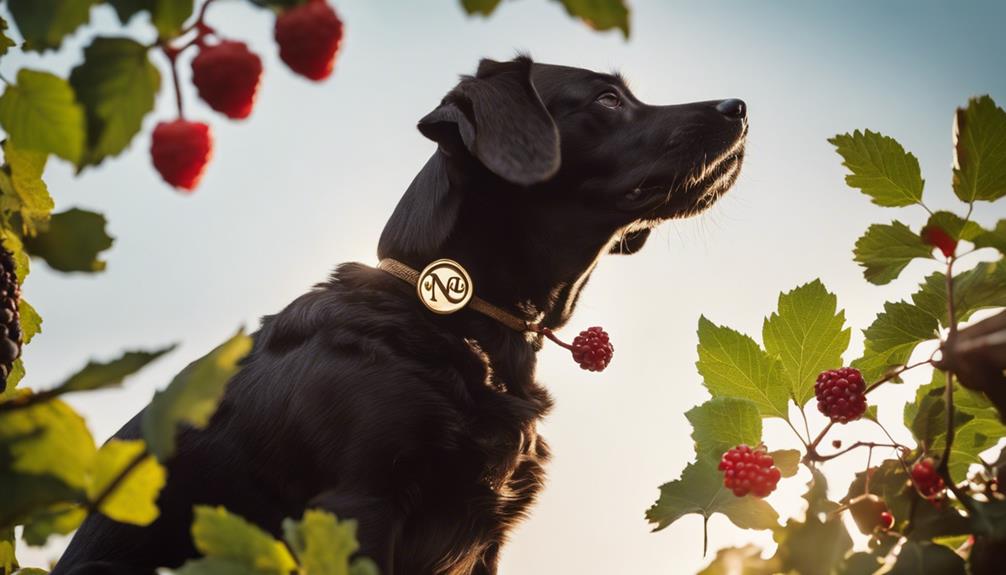
Turning our attention to mulberry leaves, we’re taking a close look at whether these are safe for dogs to eat.
It seems that generally, mulberry leaves aren’t harmful to dogs, allowing them to enjoy an occasional leaf without worry.
We’ll dive into the specifics of why mulberry leaves are typically safe, highlight any symptoms of possible toxicity in dogs, and give tips on how dog owners can safely manage their pets’ interactions with these leaves.
Mulberry Leaves: Safety Overview
Mulberry leaves are often considered safe and beneficial for dogs, packed with nutrients like fiber, vitamins, and antioxidants. However, it’s crucial to feed them to your pet in moderation to prevent any digestive discomfort.
If you’re thinking about incorporating mulberry leaves into your dog’s diet, remember a few key tips. Keep the portions small to avoid any digestive issues. Always observe your dog after feeding them new food to catch any signs of discomfort or allergic reactions early. If your dog seems unwell after eating mulberry leaves, it’s best to consult with a vet promptly.
Incorporating mulberry leaves into your pet’s diet can offer health benefits, but it should be done carefully. Ensuring the well-being of your dog means feeding them these leaves sparingly and keeping an eye out for any adverse effects.
Toxicity Symptoms in Dogs
Mulberry leaves might seem like a harmless snack for dogs, but they can actually be quite dangerous. These leaves contain substances such as alkaloids and flavonoids that can harm dogs if eaten. After a dog eats these leaves, they may start vomiting, have diarrhea, feel stomach pain, and struggle to move properly. Symptoms can get worse, leading to shaking, seizures, and breathing problems.
This shows how serious eating mulberry leaves can be for dogs and why it’s critical to get them to a vet quickly if they do. To keep dogs safe, owners should make sure their pets don’t eat these leaves.
Safe Handling Practices
To keep our dogs safe from the potential hazards of mulberry leaf toxicity, it’s essential we stay on our toes and keep those leaves out of reach. Dogs munching on mulberry leaves might end up feeling unwell, with symptoms like vomiting, diarrhea, and just feeling out of it. If your dog starts showing these signs, getting in touch with a vet right away is key.
Here are a few ways to keep your dog safe:
- Make sure to check your yard or any place your dog loves to hang out. Your goal is to spot any mulberry leaves before your dog does.
- Talk to everyone in your home about why mulberry leaves are a no-go for dogs. It’s all about keeping everyone in the loop to protect your pet.
- Think about setting up fences or any barrier that keeps your dog away from places where mulberry trees are growing.
Toxic Berries to Avoid
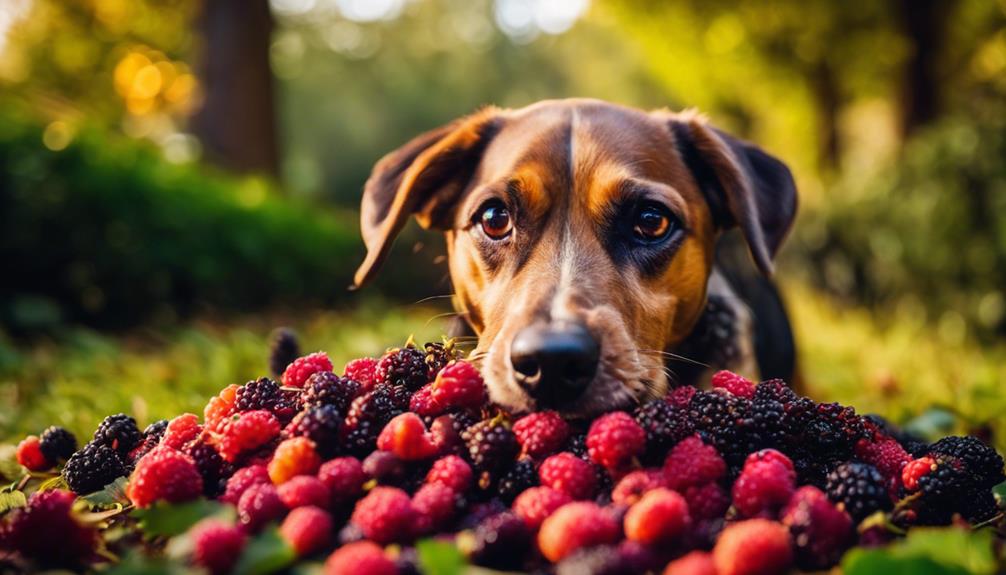
Knowing which berries are dangerous for dogs is crucial for their health. Juniper berries, pokeberries, baneberries, holly berries, cherries, and mistletoe berries can all harm your dog. Eating these berries might upset their stomach or even cause serious damage to their organs. In the worst cases, it could be deadly.
If your dog eats any harmful berries, getting them to a vet quickly is key. Fast action can help avoid major health problems. As a dog owner, it’s your job to know about these dangerous berries. This knowledge helps you keep your pet safe.
Serving Fresh Mulberries
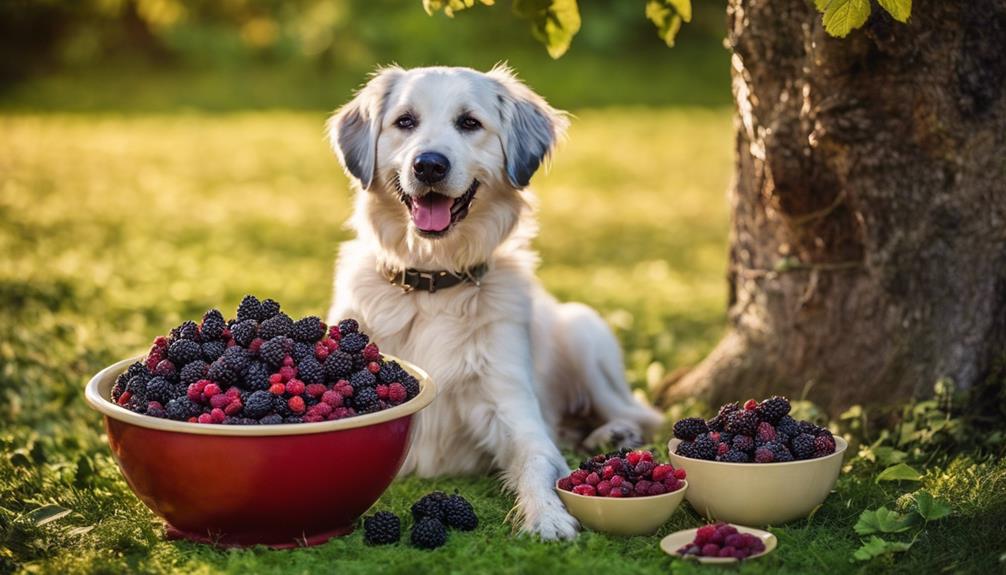
Giving your dog fresh, ripe mulberries in moderation can be a healthy addition to their diet, provided you follow some guidelines to ensure their safety. These berries are rich in nutrients and antioxidants like resveratrol, which can benefit your dog’s health by supporting their digestion, boosting circulation, and enhancing bone and brain health.
Feed mulberries in small amounts to avoid any upset stomach. Always choose ripe berries, as unripe ones might not be safe for your dog. Keep an eye on your pet when you first give them mulberries to make sure they don’t have any allergic reactions or digestive issues.
Frequently Asked Questions
Is It OK for Dogs to Eat Mulberries?
- Dogs can safely eat mulberries in small amounts.
- Mulberries provide nutrients like iron and vitamin C.
- Too many can cause diarrhea; moderation is key.
Are Dogs Allergic to Mulberry Trees?
- Dogs can react to mulberry tree pollen.
- Symptoms include skin, breathing, and stomach issues.
- Consult a vet for advice and treatment.
Why Do Dogs Eat Mulberry Leaves?
- Dogs eat mulberry leaves out of curiosity.
- They find the leaves’ nutrition appealing.
- It’s a normal way to interact with their environment.
Are Mulberry Branches Toxic to Dogs?
- Dogs can chew on mulberry branches safely.
- Watch dogs to avoid ingestion of wrong parts.
- Ensure branches are free from pesticides.

